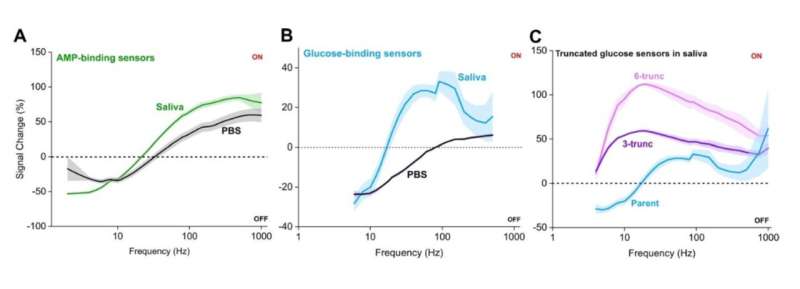This article has been reviewed according to Science X's editorial process and policies. Editors have highlighted the following attributes while ensuring the content's credibility:
fact-checked
peer-reviewed publication
trusted source
proofread
Swapping blood for spit to help with convenient at-home health monitoring

Blood tests are a common, yet often painful, step in health care. But what if we could skip the needles altogether? Saliva and blood contain many of the same biomarkers, and collecting spit is as simple as drooling into a container. Researchers reporting in ACS Sensors have developed a device that detects glucose and adenosine monophosphate (AMP) biomarkers in saliva with high sensitivity, which could help make at-home health monitoring easier and without a poke.
Blood tests provide critical information about a person's health. But they also rely on uncomfortable procedures, ranging from collecting small blood samples through frequent finger pricks to blood draws from a trained phlebotomist. Saliva has been explored as an alternative way to track important biomarkers, including glucose. However, most methods for analyzing saliva samples for small molecules require laboratory equipment.
To make the analyses convenient for at-home testing, a simple yet accurate sensing platform is needed. One possibility is the electrochemical aptamer-based (E-AB) biosensor, which produces a measurable electrochemical change when a specially designed piece of DNA or RNA, known as an aptamer, binds to its desired target.
This type of device has previously been used on blood samples, but this time, Philippe Dauphin-Ducharme and colleagues adapted E-AB biosensors for saliva samples. The team wanted to measure the concentration of glucose and AMP—a small molecule biomarker associated with gum disease—in real saliva specimens.
The team took previously reported DNA aptamers that bound to either AMP or glucose and then re-engineered them to improve their sensitivity. They created their E-AB biosensors by mounting the aptamers on a gold electrode. Saliva samples were collected from a group of participants and pooled together. The sensors were then immersed in the saliva, with no additional preparation steps or reagents needed. This simplicity makes the test easy enough to be performed by a patient in their home.
In experiments, the researchers found that their devices returned a result within 30 seconds, remained stable in undiluted saliva for up to three days, and retained sensitivity for up to a week if washed after each use. Additionally, the glucose sensor shows high selectivity towards its target, and both the AMP and glucose sensors are sensitive enough to detect the biomarkers at much lower concentrations than typically found in saliva.
The researchers say that this simple technology is the first of its kind to detect glucose in human saliva, and they hope it can make at-home health monitoring less invasive and easier to complete, especially for people with chronic diseases such as diabetes.
More information: Minh-Dat Nguyen et al, Electrochemical Aptamer-Based Biosensors for Measurements in Undiluted Human Saliva, ACS Sensors (2023). DOI: 10.1021/acssensors.3c01624
Journal information: ACS Sensors
Provided by American Chemical Society





















